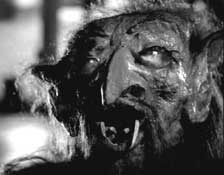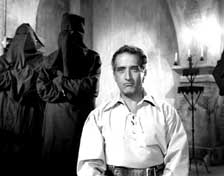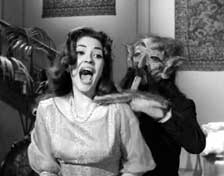 THE
BRAINIAC (1961)
THE
BRAINIAC (1961)Director: Chano Urueta
CasaNegra
 THE
BRAINIAC (1961)
THE
BRAINIAC (1961)In 1661, Baron Vitelius (Abel Salazar, a primary figure in Mexican horror who also produced) is cited for practicing necromancy and other perverted shenanigans by the Spanish Inquisition. During his trial, he smirks and magically frees himself from the chains that bound him. But the Baron is burnt at the stake, and swears vengeance against the descendants of the Inquisitors. In 1961 -- 300 years later -- a comet approaches earth via a cheap still photograph effect that looks like something you might see on "Mr. Rogers' Neighborhood." When the comet "crashes," we witness a paper mache mass gently lowered to the ground by cables. Out from the smoke comes the Baron, now a hideous monster with an enormous head, extensive fork tongue, and hose-like two-fingered claw hands.

An innocent bystander pulls up in a car to witness the arrival of the monster. In a night-time set very reminiscent of the graveyard in PLAN 9 FROM OUTER SPACE, the Baron kills the poor clod by extending his tongue out and presumably sucking out the guy's brains through the back of his neck (the method that the "Brainiac" bestows on all of his victims). Leaving the fellow dead on the ground in his underwear, the Baron obtains his expensive suit. Now looking like a smooth Sheldon Leonard (circa 1940s), he takes on a suave human form and assumes more victims. The Baron easily attracts a cheep floozy in a bar and a hooker in the streets with his natural charms and his hypnotic glare (enhanced by a bright spotlight applied to his face), then quickly transforms into his monstrous persona to suck the life out of them. When it's time to seek out the descendants of his Inquisitors, he holds a fancy dress party and invites them to his majestic abode, where he models fashionable suits and smoking jackets. When he's not entertaining the guests he intends on squashing, he sneaks off into a room for a little snack. A cabinet reveals an ornate serving bowl full of brains that he nibbles on with a long spoon (well, brains are a delicacy).

The Baron ends up sucking the brains of the descendants and their spouses, including one character played by Mexico's answer to Bela Lugosi; German Robles (THE VAMPIRE, THE VAMPIRE'S COFFIN). With his twirly mustache, goatee, and gray-touched hair (Robles was only in his early 30s at the time, but made to look middle-aged), he resembles a comical Hans Conreid (or even Three Stooges foil Emil Sitka), making a dumb face when he's stunned and forced to watch the Baron kill his daughter. During the climax, the young hero (Rubén Rojo) discovers the hidden brain food as the Baron tries to assault his girl in another room. But the clowny police arrive just in the nick of the time to destroy the Brainiac --"Ghostbusters" style -- with massive flame-throwers. If the flame-throwers don't do him in, cigarettes certainly will. On screen, Salazar smokes one cigarette after the other, and there's usually a lit one clutched in his fist while he's trying to make a point. What a riot!

Originally titled "El Baron Del Terror," THE BRAINIAC is one of dozens of films dubbed into English by K. Gordon Murray and distributed straight to TV by AIP. With a profound title that's not easily forgotten, soundstage-bound sets, awkwardly hilarious dubbing, and an outrageous monster (with a head that pulsates!) that's just as memorable as anything Paul Blaisdell created for AIP in the 1950s, THE BRAINIAC is one of the most popular of the Mexican monster romps (if not THE most popular). Like most of these Mexican fantasy efforts, it's pure enjoyable Saturday afternoon fun, and it ranks rights up there with the best "bad" movies. Thankfully, the original Spanish language track is presented here, actually giving the proceedings more credibility, if that’s possible. Put your brains in the cupboard and delight in this South of the Border-lensed trash.
 Continuing
a great tradition of releasing official versions of Mexican horror favorites,
CasaNegra gives THE BRAINIAC its first authorized video release in the U.S.
Looking miles better than the previous public domain versions out there, the
full frame black and white image is crystal clear with fine picture detail and
excellent contrasts. It’s great to finally hear the film in its original
language (in mono, with optional English subtitles), and the English-dubbed
track is also on hand. While not as robust as its Spanish counterpart and a
bit scratchy, it’s still serviceable and sounds fine. One brief scene
has no English dialogue, so it jogs back to Spanish for a few seconds, so you
should have your remote handy to bring up the subtitles at that moment. The
print also features the original Mexican titles, which boasts some of the same
macabre drawings found at the opening of THE WITCH’S MIRROR. As with all
these CasaNegra releases, the disc’s menu is accessible in English or
Spanish, and the cover has a reversible Spanish-language side.
Continuing
a great tradition of releasing official versions of Mexican horror favorites,
CasaNegra gives THE BRAINIAC its first authorized video release in the U.S.
Looking miles better than the previous public domain versions out there, the
full frame black and white image is crystal clear with fine picture detail and
excellent contrasts. It’s great to finally hear the film in its original
language (in mono, with optional English subtitles), and the English-dubbed
track is also on hand. While not as robust as its Spanish counterpart and a
bit scratchy, it’s still serviceable and sounds fine. One brief scene
has no English dialogue, so it jogs back to Spanish for a few seconds, so you
should have your remote handy to bring up the subtitles at that moment. The
print also features the original Mexican titles, which boasts some of the same
macabre drawings found at the opening of THE WITCH’S MIRROR. As with all
these CasaNegra releases, the disc’s menu is accessible in English or
Spanish, and the cover has a reversible Spanish-language side.

Extras include a running commentary Kirb Pheeler, one of BRAINIAC’s biggest champions, and creator of the Brainiac Interactive Press Kit (also found on this disc’s special features). Pheeler brings a welcomed sense of humor (he actually served tapioca pudding with long stem spoons to guest during party viewings of the film) when discussing many of the film’s off-the-wall scenes, and also shares trivia and facts about the cast, crew, its production, its American distribution and dubbing, its undeniable reputation and much more. Other extras include a wonderfully sincere essay by Casamiro Buenavista; a still/poster gallery; Biographies on actors Abel Salazar, Ariadne Welter, David Silva, German Robles and Rene Cardona (the legendary director is featured in a small role); a 1969 U.S. radio spot created when the film briefly played theatrically with CURSE OF THE CRYING WOMAN; and an exclusive CasaNegra Loteria Game Card. (George R. Reis)